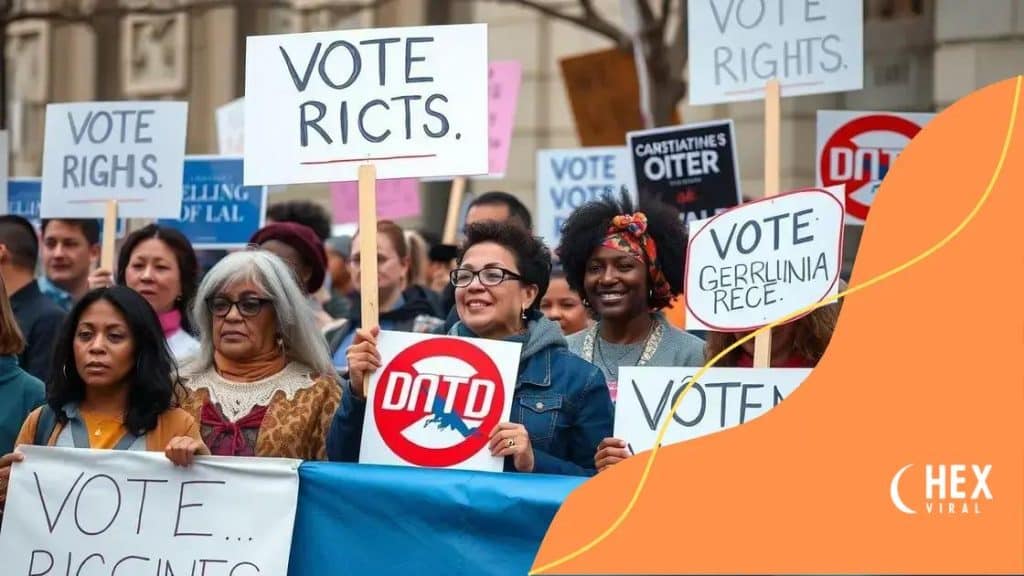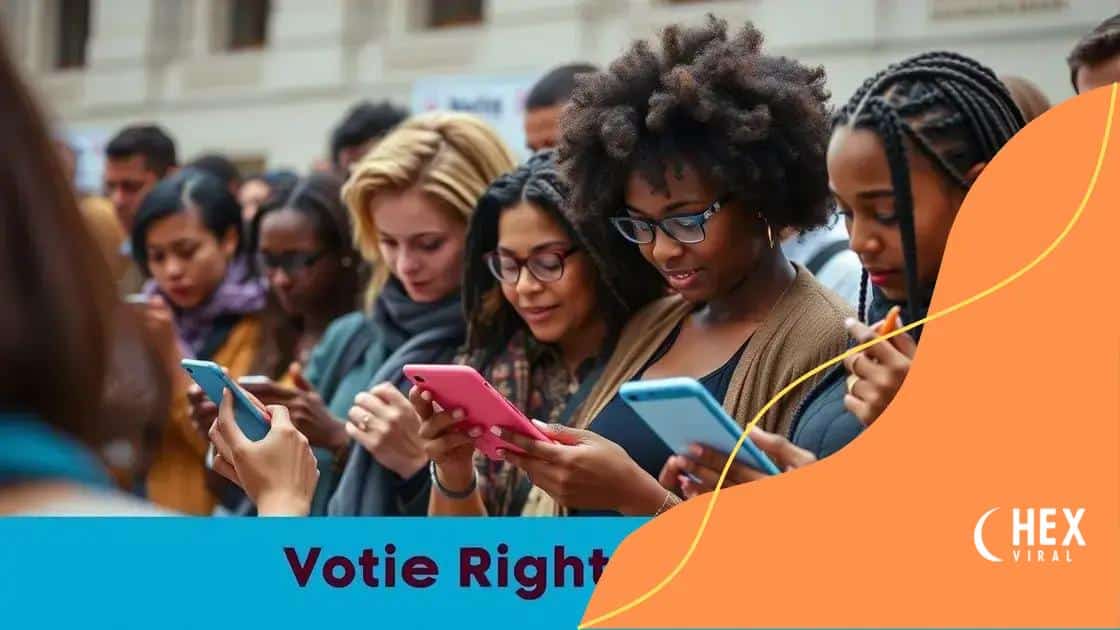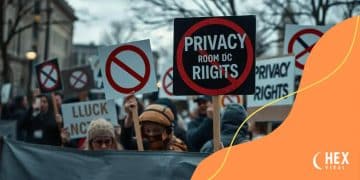Anti-gerrymandering voting rights protests that inspire change

Anti-gerrymandering voting rights protests aim to eliminate biased redistricting practices, ensuring fair representation and empowering individuals to engage in the democratic process.
Anti-gerrymandering voting rights protests have emerged as powerful movements aimed at redefining fairness in elections. These grassroots efforts engage citizens in shaping the democratic process. Have you wondered what motivates these activists?
Understanding anti-gerrymandering efforts
Understanding anti-gerrymandering efforts is crucial for anyone interested in the democratic process. These initiatives seek to eliminate biased redistricting practices that can skew election results. By becoming informed about how these efforts work, individuals can better engage in conversations about voting rights and representation.
What is Gerrymandering?
Gerrymandering refers to the manipulation of electoral district boundaries to favor one party over another. This can lead to significant discrepancies between the percentage of votes received and the number of seats won. Many states have seen these tactics used to suppress voting rights.
The Goals of Anti-Gerrymandering Efforts
The main goals of anti-gerrymandering campaigns include:
- Ensuring fair representation for all voters.
- Reducing partisan influence in district maps.
- Encouraging competitive elections.
- Increasing public trust in the electoral process.
To achieve these goals, activists often use data and technology to propose fairer maps. Organizations work tirelessly to highlight the negative impacts of gerrymandering on democracy. It’s essential to be aware of how these efforts can transform the electoral landscape while promoting a more inclusive society.
Many states have implemented independent commissions to oversee the redistricting process. These commissions are designed to remove political bias from map-making, ensuring a fair distribution of electoral power. As citizens, understanding the importance of these committees can help advocate for changes in areas where gerrymandering is still prevalent.
Moreover, grassroots movements often play a significant role in pushing for legislative reforms. By gathering signatures for petitions or participating in public demonstrations, constituents can voice their demands for fair districts. Engaging in local activism not only raises awareness but also stresses the importance of transparent political processes.
Staying informed about the ongoing developments in anti-gerrymandering efforts is vital as new legislation emerges. Follow updates from reliable news sources or non-partisan organizations dedicated to voting rights to keep your knowledge current. Understanding the landscape of gerrymandering allows you to participate meaningfully in the dialogue surrounding democracy.
Key protests that shaped voting rights
Key protests that shaped voting rights have played a crucial role in advancing democracy in the United States. These grassroots movements highlight the struggle for fair representation and the importance of giving a voice to all citizens. Understanding these historical events can inspire and inform current efforts, especially those focused on anti-gerrymandering.
The Civil Rights Movement
The Civil Rights Movement of the 1960s was instrumental in advocating for equal voting rights. Many protests sought to challenge discriminatory laws that prevented African Americans from voting. Events like the Selma to Montgomery marches highlighted the urgency of expanding access to the ballot.
The Women’s Suffrage Movement
The Women’s Suffrage Movement also significantly influenced voting rights. The fight for women’s right to vote included numerous protests, rallies, and marches. These efforts culminated in the passage of the 19th Amendment in 1920, ensuring that women could participate in elections.
Modern Protests Against Voter ID Laws
In more recent years, protests against voter ID laws have emerged. Many believe these laws disproportionately affect minority groups. Activists have mobilized to highlight the challenges faced by those who lack specific forms of identification. Participating in these protests has helped raise awareness of voting accessibility issues.
Notably, each of these historical protests shares a common goal: to advocate for fair and equitable access to the electoral process. As movements evolve, they often build on previous victories and lessons learned, ensuring that the fight for voting rights continues.
Today, the legacy of these key protests inspires new generations to take action. Activists utilize social media and online platforms to organize events, spread information, and mobilize support for their causes. Understanding the past equips individuals and communities to continue working toward a more just electoral system.
The role of social media in organizing

The role of social media in organizing anti-gerrymandering efforts cannot be understated. It has become a vital tool for activists and organizations to engage, inform, and mobilize supporters. Platforms such as Twitter, Facebook, and Instagram provide spaces for discussion and awareness.
Connecting Communities
Social media connects individuals who are passionate about voting rights. People can share their experiences, stories, and strategies. This connection fosters a sense of community among activists who may be in different locations but share a common goal.
Real-Time Updates
Activists use social media for real-time updates during events and protests. Streams of information can reach thousands in an instant, turning public attention to important issues. This rapid communication keeps supporters informed and engaged.
Moreover, hashtags like #EndGerrymandering and #VotingRights become rallying cries that unify efforts across the country. These tags allow users to follow discussions and stay current on related events. It creates a virtual space where people can support one another.
Fundraising for initiatives has also transformed through social media. Organizations share campaigns and donation links, making it easier for people to contribute to causes they care about. This ability to engage with potential donors online increases support for anti-gerrymandering measures.
Furthermore, social media enables educational campaigns that inform the public about the implications of gerrymandering. Infographics, videos, and articles can be easily shared, reaching wide audiences. Users are empowered to learn more and share this important information with their networks.
As the landscape of organizing continues to evolve, the impact of social media will likely grow. Utilizing these platforms effectively can enhance the strategies of those fighting for voting rights. Understanding this role helps activists harness these tools to drive change in their communities.
Impact of grassroots activism on legislation
The impact of grassroots activism on legislation is significant and growing. Grassroots movements have the power to change the political landscape by mobilizing ordinary citizens to advocate for social and political change. These efforts often lead to crucial reforms, particularly in areas like voting rights.
Amplifying Voices
Grassroots activism gives a voice to those often overlooked by traditional politics. By organizing communities to speak out, these movements amplify their demands for fair legislation. This collective action can put pressure on lawmakers to address issues like gerrymandering, ensuring that more people are represented fairly.
Successful Campaigns
Many successful campaigns in the past have shown the effectiveness of grassroots activism. Examples include:
- The movement for the Voting Rights Act of 1965.
- Protests against voter ID laws in various states.
- Local efforts to establish independent redistricting commissions.
- Mobilizing public support to eliminate unfair voting practices.
These campaigns have one thing in common: they rely on ordinary citizens who are passionate and dedicated to seeking change. When people come together, they can create a powerful force that influences policymakers.
In addition to direct action, grassroots movements often use social media to raise awareness and gather support. By sharing stories and information widely, they can educate the public and build a network of allies. This digital presence is crucial in mobilizing support and rallying voters before an election.
Moreover, legislators are increasingly paying attention to their constituents’ voices. When enough people advocate for change, elected officials feel compelled to respond. This influence can lead to meaningful reforms and altered legislation that better reflects the will of the people.
As grassroots activism continues to grow, so does its impact on shaping the future of democracy. Understanding how civic engagement affects legislation encourages more individuals to join these movements and advocate for their rights.
How you can get involved in the movement
Getting involved in the anti-gerrymandering movement is easier than many think. Every individual can contribute to the fight for fair voting rights. Here are some ways to engage in the movement and make a real difference.
Educate Yourself and Others
Knowledge is power when it comes to activism. Start by learning about the issues surrounding gerrymandering and voting rights. Share this information with friends, family, and your community. You can:
- Read articles and books on the subject.
- Attend workshops or lectures.
- Follow reliable sources on social media for updates.
By educating yourself and others, you foster awareness and understanding of the importance of voting rights.
Join Local Organizations
Many organizations focus on fighting gerrymandering and advocating for voting rights. Connecting with these groups can amplify your efforts. You can:
- Volunteer your time for events and campaigns.
- Participate in local meetings and discussions.
- Help with administrative tasks or outreach initiatives.
Being part of a community that shares your passion can provide valuable support and resources.
Participating in rallies and protests can also make your voice heard. These events usually attract media attention, which can help spread the message further. When there are calls to action, don’t hesitate to join in.
Additionally, engaging online can help mobilize more support. Share information about events, upcoming votes, and important issues on your social media platforms. Encourage others to participate as well.
Contact Your Representatives
One of the most effective ways to influence legislation is by contacting your elected officials. Reach out to them to express your support for anti-gerrymandering measures. You can:
- Send letters or emails to your representatives.
- Make phone calls to their offices.
- Participate in town hall meetings to ask direct questions.
Your representatives need to know that their constituents care about voting rights. Your voice matters, and it can help drive policy changes.
Finally, consider informing others about the importance of voting and fair representation. By spreading awareness and encouraging participation in elections, you can change the landscape of democracy. Every small action contributes to a larger effort for justice.
In conclusion, getting involved in the anti-gerrymandering movement is essential for creating a fairer electoral process. By educating yourself and others, joining local organizations, reaching out to representatives, and using social media, you can make a significant impact. Every small effort counts, and together, we can advocate for the vital voting rights that keep democracy alive. Stay engaged, and let your voice be heard!
FAQ – Frequently Asked Questions about Anti-Gerrymandering Activism
What is gerrymandering?
Gerrymandering is the manipulation of electoral district boundaries to favor one party over another, often undermining fair representation.
How can I get involved in anti-gerrymandering efforts?
You can get involved by educating yourself and others, joining local organizations, and participating in community events and protests.
Why is grassroots activism important?
Grassroots activism empowers ordinary people to influence policy decisions and advocate for change, making democracy more inclusive.
How does social media help in these movements?
Social media helps to spread awareness, mobilize supporters, and facilitate real-time communication about events and actions related to voting rights.






